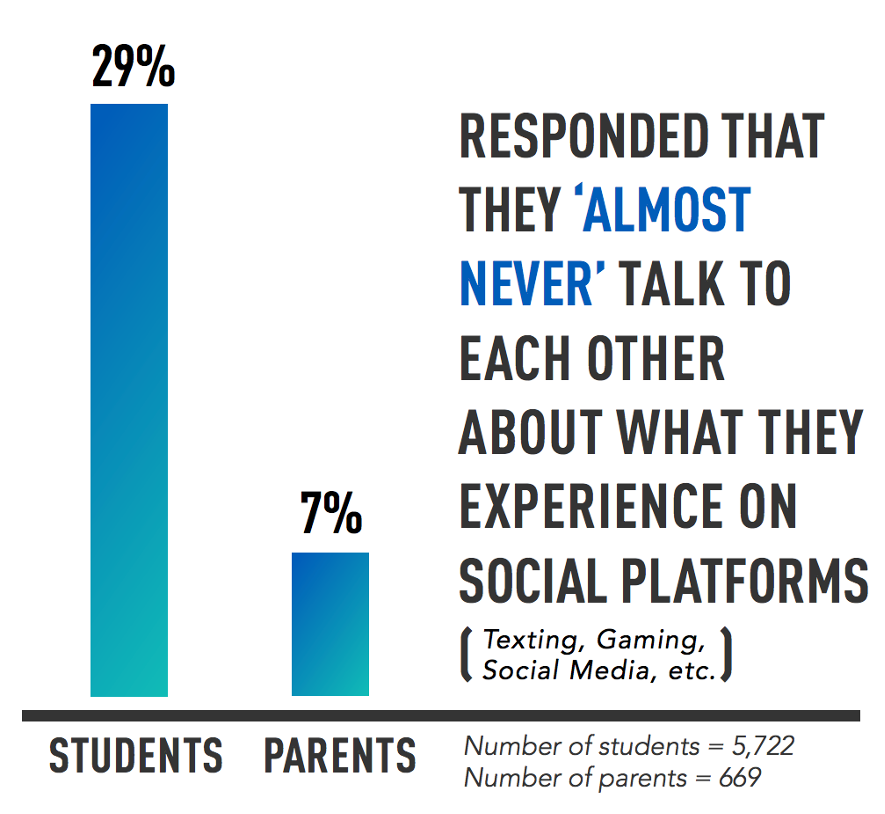Digital Divide: What Parents Have Wrong When It Comes to Students and Social Media

In my work helping students across the country navigate social media, I’ve heard from tens of thousands of tweens and teens directly about how they are using social media on a daily basis. I also get to connect with parents – learning about their biggest challenges and concerns when it comes to being a good digital parent.
In my discussions with both parents and students, one observation is startling clear: there is a great disconnect in how students and parents talk about technology and social media.
We surveyed more than 5,000 students at our partner schools and sent many of the same questions to their parents. For some of them, the data revealed a startling disconnect. Take, for example, the question of how often parents and students talk about their online experiences. Students are over four times more likely to say that they “almost never” talk about their experiences on social media compared to what their parents report.

And that’s not all. As I’ve spoken with students and separately parents throughout the years, I’ve noticed some other ways that parents and students are digitally disconnected. Here are some of the biggest social media myths that have parents concerned:
Myth #1: Social Media Creates Pressure to be Perfect
Contrary to what many parents believe, the majority of students polled say they don’t feel pressure to create the perfect life online. In fact, when we asked this question of middle schoolers, only 10 percent said they felt this pressure. Students tell us it’s more important to be genuine and show off their fun side. They enjoy having Finstas (“Friends-only” Instagram accounts) and back-up TikTok accounts where they can be lighthearted, share their outtakes, and project a more authentic version of who they are.
Myth #2: Social Media Will Only Jeopardize College Acceptance
Parents worry that what students post on social media could harm their chances of getting a job or getting into college, and this has happened in extreme cases. In 2017, Harvard rescinded offers to ten incoming freshman who participated in a Facebook group that included racist memes and other crude content, including jokes about child abuse and the Holocaust. This was not “teens being teens,” it was a highly offensive account.
While it’s true that 59 percent of college admissions officers say it’s fair game to check applicants’ social media according to a 2019 Kaplan survey, we’ve found that a positive social media presence can help set students apart from their peers. Many high school students today are using social media to showcase their talents, even embracing platforms like LinkedIn and Google+ to connect with recruiters, coaches, and future bosses.
Kaplan’s survey of college admissions officers shows that 36 percent will check out an applicant’s social media profiles, up from 25 percent a year prior. But while more universities are looking at prospective students online, it’s not necessarily a bad thing. In fact, Kaplan’s survey reveals that admissions officers are more likely to find something that bolsters a candidate’s profile (38 percent) rather than something negative (32 percent).
We asked 94 rising high school seniors if they had a LinkedIn profile. Only eight of them said yes. That’s just one opportunity that we have to flip the switch on the notion that social media can ruin, rather than enhance, reputations.
Myth #3: Social Media is a Waste of Time and Not Productive
We all know that socialization is vital for the healthy development of tweens and teens. While past generations would go to the movies or mall, iGen uses technology to connect (even before the days of social distancing)! Put another way, social media is simply how students today socialize, period. Consider dropping “media” from the term “social media” and just calling it “social,” because that’s what it is, especially in the times we’re living in.
Bridging the Digital Divide
So how can parents and students get on the same page? First off, huddle rather than helicopter.
A 2017 study published in the Journal of Adolescence found that teens who believed their parents were snooping on them shared less information than teens who felt their parents were respecting their space and boundaries. Of course you want to supervise them, but make sure they know your intentions so it doesn’t feel like a secret invasion of their privacy.
Next, keep the lines of communication open by huddling often about how your child is using social media and technology. Just like you would ask “what happened at school today?” or “how was baseball practice?” ask “what happened on social today?” More specifically, ask who they’re texting with. Ask them to show you who they’re following on Snapchat and why. Ask about who they’re talking to when they’re gaming. Ask to “friend” and follow them on social media.
And if you haven’t already, create a family tech contract that all family members adhere to, parents, included. In our survey of parents, only 16 percent say they have signed a family tech contract, while another 62 percent said they are interested in having one.
With input from students and parents, we created the Family Social Standards Agreementâ„¢. When families sign it, they promise to help each other live up to high standards, together.
Social media is here to stay and can enrich our lives if we use it right. We can inspire tweens and teens to make good choices online and in real life by huddling often, getting on the same page, and holding each other to high standards.

 Laura Tierney
Laura Tierney